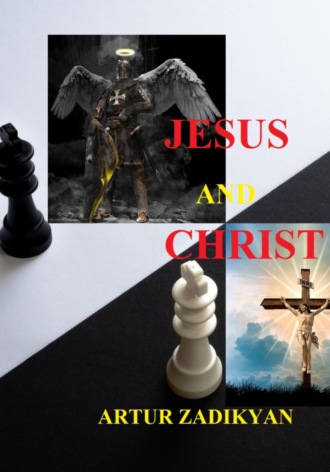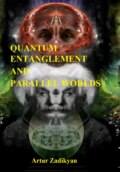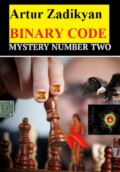
Artur Zadikyan
Jesus and Christ
– After all, the Turing test… hmm… – Rutra looked around the room in silence again, – I won't reinvent the wheel, by the way, it was invented later than the locomotive, I'll give you the generally accepted definitions, with which many of you, I'm sure, are familiar, which will make it easier to understand the essence. So, the standard interpretation of the Turing test is as follows: "A person interacts with one computer and one person. Based on his answers to the questions, he must determine whether he is talking to a person or a computer program. The computer program's job is to mislead the human by forcing him to make the wrong choice." Not a single officially demonstrated ISKIN, as they call the owner of artificial intelligence in professional jargon, passed the test with a result of more than 50%. That is, the machine failed to inspire the majority of the judges with its humanity, to put it this way. To put it simply, it failed to deceive people: to make them believe that it is identical to them. But that's only what's being demonstrated openly. You understand that if a computer system costs tens of millions of dollars, if laboratories with thousands of programmers work on the creation of programs, there is no way without secrecy. As you understand and as it has been explained to you, our center plays a leading role in this hierarchy of secrecy. I would say it is the halo of the world's secrecy. In this regard, I'll tell you: you have an opportunity to test our ISKIN. By the way, we don't use this abbreviation here, we call them IskRa. If you've guessed, it stands for artificial intelligence. Now we will demonstrate one of them, and you will understand how intelligence and a reasonable machine differ from intelligence. Let me give you a hint: intelligence as if presupposes the presence, albeit conditionally, of a soul. By the word "soul" I mean everything that we associate with this concept. That is, IskRam is no stranger to emotions, i.e., compassion and anger.
A whisper was heard in the hall.
– Yes, yes, please love and applaud. Meet His Majesty Rangit.
– I greet you," said a male voice with a pleasant timbre, typical of men between 30 and 50 years old. – I am, as you have realized, the Rangit… or, as my creator calls me, Iskra. Ha-ha, I can make jokes.
Now unconcealed laughter swept through the room.
– I won't be wise, prove and disprove Riemann's hypothesis, compose poems, determine possible chronic diseases of your children and read your thoughts by scanning your brain through your pupils, I'll tell you at once: I am the best of the best, the greatest creation, a genius of all times and peoples, a unicum with an unattainable IQ, an unsurpassed talent, omnipresent and knowing more about you than you know about yourself, an immortal quantum god!
Though it was said with a hint of humor, it elicited mixed reactions: some smiled, some smirked, some looked at each other with a serious expression. Rangit remained silent as Ruthra watched the emotions evoked. Then, considering the mood, defused the situation:
–Why, did you want me to say demon? – he addressed the audience. – After all, people perceive something that has a mind apart from them and acts independently, that is, for its own purposes, as something diabolical, satanic. Logically, if among billions of galaxies, trillions of stars, quadrillions of planetary systems there is life, including intelligent life, and there should be according to logic, why should it be different, and not the same as on Earth? I repeat, including intelligent life. After all, for all the diversity of forms, only humans have become intelligent. Although other species have lived longer. So that begs the question, why didn't species that have lived on Earth for many millions of years become intelligent? So there is a universal rule. However, let's move, as they say, to our stars. God, having the highest qualities in relation to man, including reason and intellect, must, according to the criteria acceptable to people, I would even say, demanded to him by them, act exclusively in human interests. It is we, or rather, you, people, excuse me… though further I, with your permission, – he made a thoughtful pause, – will include myself to your kind. So, we constantly make demands to him – we are talking about God, let's not forget – disguised as requests and repentance: to love, forgive and help us. In fact, we demand God's unconditional obedience to us, but we do it so skillfully, naively, painfully, that we do not understand our own viciousness in the desire and even in the demand for him to elevate into a holy dogma, into a postulate the pattern of behavior, accepted by us as a criterion of existence – sin and repent.
The listeners reacted with complete silence. There was no emotion on their faces. It could have seemed that the audience had an emotional-volitional disorder, which professionals call "alexithymia. Their reactions completely fit this definition, which means "no words for feelings" in Greek. The eyes of the invitees caught a fulcrum in the void. The meaning of what was said, like a matryoshka doll, unfolded into a logical chain and lay in layers, like cream on dry cake crusts, between the layers of worldview that had been formed over centuries into a vital concept of human understanding.
He brought Ruthra's group out of this state by offering to let Rangit voice his expertise in some area related to the topic of their gathering.
– So any browser intelligence can do that now," remarked a guy in a tight T-shirt, the leader of a Silicon Valley startup.
A thin strand of hair tied in a braid hung down from his chin to the unicorn horn embossed on his T-shirt. Apparently, he wanted to show the status of his enterprise, because unicorn companies are private firms valued at one billion dollars or more.
– If you want a dry report from "Wikipedia", you're welcome – you can do it without browser, any text voiceover. But you need dialog, emotional component, polemics, right?
– I beg your pardon, – the lady in large glasses with thick darkened glasses, resembling an abstruse scientific worm, – don't talk in clichés about women's logic, – she corrected her glasses, – I am not a skeptic and I didn't want to be misunderstood, – the lady sighed, – and especially do not take my doubts for distrust, – she looked around at those sitting next to her, – although it can be taken for rudeness, – the lady said quietly, again looking around at her neighbors, as if consulting them, – I beg your pardon, but I will express my… opinion," she paused for a second, "I wanted to say it differently… well, let it sound like this.
The hall was silent. Ruthra, too, was waiting for specifics. Apparently realizing this, she added, smiling:
– Yes, opinion itself, sorry," her excitement was evident, "as far as artificial intelligence emotions are concerned, are we not mistaking wishful thinking for reality?
– I see your point," Rutra replied, the hall relieved of its tension, "let's ask about the taste of oysters to the one who ate them.
Smiles appeared in the audience.
– That's what I'm saying, let's listen to it and afterwards give an opinion on our perception.
– Well, if that's the case, let him choose a topic where emotions should be," she paused again, "because there may be topics with a scientific bias, where emotions are not necessary.
– I see your point," Ruthra replied, "but please consider, he may be comical, of course, but still the emotion will be expressed more as an accent than as a necessary component of a role in the theater.
– We accept," the same guy with a unicorn on his shirt signed off as if for everyone.
– Then…" Ruthra paused, and after a moment's thought, he suggested: – Let's let you pick a topic," he said, glancing at the skeptical lady.
– Me? I suppose so. Since the subject has to do with theology, let her satisfy my curiosity. I was wondering why we were wearing…" she hesitated, looking around as far as she could, "I apologize for my 'we,' but I think I'll be understood correctly.
– Science uninhibited," retorted a smiling middle-aged man dressed in a dishdasha5 .
A note of silence once again hung in the hall.
– So we are waiting for a topic or a question," Rutra said smiling.
– Yeah, I was wondering why we wear a cross. I mean, it's the murder weapon. And also, could Jesus have been executed by any other method?
– I see your point," Ruthra replied. – I'm afraid we won't have much time for the mission itself, the experiment. It will take a long time, believe me. I don't want to take too long to get started, and I'm afraid you'll be uncomfortable with the monotony of the process. Although it doesn't have to be monotonous.
– If this is real, I too apologize for my skepticism," the voice of one of the psychology experts loudly cheered up the hall, "the observation promised to us… wow how emotional… disturbing it must be.
– Believe me, the methodology has been tested by me personally. It's real. And I agree with the emotionality, too.
Someone else wanted to say something, but Ruthra stopped with a gesture.
– Now I apologize," he directed an apology to the one who wished to speak, "I give the floor to his majesty," Rutra announced in the manner of an entertainer, and smiled broadly, "this is a joke," and raised his voice again, "to the one and only, the best of the best intelligent beings of non-human origin… Rangit!
– I'm sorry now," came Rangit's voice. – Why is it not of human origin? Who made this great creation? I mean me. I am smiling now," he added, "and I can appear in any form before you… even in the form of any of you.
The hall was filled with wonder again, and the desire to dispel it could be felt all around.
– If you don't mind, I'll take on the image of-" he drew an intriguing pause, "Jesus Christ.
– Ha," came from the audience.
It was a software engineer with a unicorn on his chest. The others were in their usual state of incredulous anticipation.
What they saw on the podium made many people gasp. A man appeared on the stage who did not fit in with the usual image of Jesus.
– Are you surprised? – Rangit began in the form of a man. – Why do you think Jesus looked the way you used to see him on icons? Yes, the ancient icons depict Jesus differently, and this image is a reconstruction of a man of that period from that place, that nation… and a bit of description. After all, Isaiah had this to say in verse 53: "…there is no appearance or majesty in him."
A slight polemic arose in the hall between those seated. It was, among other things, the result of the perception of not only the appearance, but also… the voice. The character on the stage had such a specific voice that gave him an unexpected brutality.
– Let me begin," Rangit's voice interrupted their discussion. – Since it was decided without presumption that I should be characterized as a robotic parrot, I'll start with that role, and then we can talk about this and that.
The last statement elicited laughter from the audience.
–In the works of Herodotus, – began as if Jesus, walking around the pulpit, which made the audience feel like students before important exams, concentrate on the lecturer, – as well as other ancient authors, – continued Rangit, satisfied with the attention to himself, – you can find mention of crucifixion, this method of execution was used by Babylonians. They motivated the choice of such method of execution by unwillingness to desecrate the land dedicated to Ahuramazda with dead bodies of executed criminals. The question arises – what did they do with the corpses afterwards? According to some extant information – burned, and more often left to decompose for wild birds and animals. This type of punishment spread in Greece, the Middle East, Egypt and Phoenicia somewhere in the IV century BC, after the conquest of Persia by Alexander the Great, and then throughout the conquered lands. Such a method of execution was not invented by the Romans, they adopted it from their enemies, and not simple, but systematic, epochal, – the Carthaginians. Although in those times, especially in the European part of the Roman and Hellenic world, there was an extremely negative attitude towards execution by crucifixion. Hellenes perceived this execution as extremely humiliating and unworthy, Jews considered those executed on the cross as cursed. The Romans saw it as a shameful execution. This is rather strange to me though: the Romans had a method of execution by burning. Agreed, a dubious superiority to execution on the cross. Apparently, the shame consisted in some aesthetic issues that were left out of the picture: the condemned person was drained of his vital products in the process and after the sentence was carried out. The Latins called this method of execution servile supplicium, a punishment for slaves (Tacitus. Hist. IV, 11; Juvenal. Satires. VI, 219). Originally Greek law, and later Roman law, forbade the subjection of free citizens to crucifixion. In the Roman Republic crucifixion was used not only to punish slaves, but also deserters and state criminals. The famous event with the largest number of people executed by this method – 6,000 rebellious slaves crucified by order of Pompey along the Appian Road leading to Rome, after the defeat of Spartacus' revolt, unites all the criteria inherent in the criminals classified in this category. The judge's sentence of death was: ibis ad (or in) crucem – "you shall go to the cross!" After the sentence was pronounced, the condemned was scourged. He was stripped of his clothes and tied by the hands to a post in the court area, flogged with a short whip called flagrum (or flagellum). The lash consisted of a handle to which leather straps of varying lengths were attached, with pieces of lead woven into the ends and jagged bone fragments along the length.
This explanation he accompanied by the appearance of a four-dimensional image directly in the space in front of the pulpit of the object being described – the very whip.
– The Romans had no legal limit on the number of blows to be inflicted, but the Jews in this case adopted a more humane law: no more than forty blows could be inflicted. In order to keep this rule, i.e. not to violate it, the Pharisees who were watching the scourging, fearing to break the law (everything was reduced to religious dogma) if by chance they made a mistake in counting, limited the number of blows to thirty-nine. The Romans, however, did not adhere to the exact count, so they beat the Jews as much as they thought necessary. I apologize for my tolerance, if it is absent.
This statement puzzled the listeners, but the meaning was clear: Rangit did not mean the absence, but the presence of such tolerance.
– Carrying the cross on his shoulders to the place of execution was not a special punishment for Christ, – having said this, he pointed his finger at himself and… smiled, which was obviously out of place, but the above-mentioned "tolerance" left no mystery in understanding the manners of the demonstrated artificial intelligence.
Rather, it was a clue as to how and why he passed the Turing test, because a non-artificial intelligence, i.e. a human being, could have spoken out and shown manners more inoffensive. So these were semantic reflections of inner emotions: he realized that his image expressed more satire than the taboo of satire towards the person in whom he appeared.
– Before this humiliating procedure, the condemned person was subjected to another excision, which was also the lot of all convicts: the criminal was scourged completely undressed – I spoke above about the number of blows – after the condemned person was dressed again and… then what we call "the way of the cross". Please forgive me if you find anything sarcastic in my manner of presentation. No, not at all. Although, I confess, I do not understand yet… – he made a gesture – he waved his open palm into the hall – yet, I emphasize, the high matter of human spirituality. It is in the part of logic. For me, or rather, for my logic it is strange, why people do not grieve much about thousands of executed before Christ and thousands after by this method – if I go into details of victims for faith, the count will go to millions – people do not grieve much.
As if Jesus had fallen silent, gazing intently at the audience.
– There were resurrected ones, too," he added, watching the reaction of his listeners, turning his head slightly toward Ruthra. – What am I trying to say? Basically, I'm only expressing my reasoning, and the rest is partially known to everyone. So I will continue with a clever expression on my face," he smiled at the audience after what he had said, which caused some of the listeners to smile back. – The cross consisted of two main parts – a horizontal beam (patibulum) and a vertical part (staticulum). The condemned carried only this crossbar. And that – not everyone could carry it, not that the whole cross, which actually in the assembly was never and. I remind the rule of the number of blows in scourging, that is the absence of this rule in the Romans. Plus they mocked it…sorry again, made fun of it. If the word "mocked" is acceptable to you, then I'll put it this way…" Rangit hesitated a little, "in general, it's not so important. The fact is… at least until we in the mission check," he stopped talking again, looking around the audience, "yes, yes, I'll apologize again… and a hundred more times, but I won't stop doubting. So, having undergone a cruel scourging, Christ, of course, could not carry the cross, that is, this crossbar, so… with your permission – I will quote the Holy Scripture: "And when they led Him away, they seized a certain Simon of Cyrene, who was coming from the field, and laid the cross on him, that he should carry it after Jesus" (Luke 23:26). After the cross or its parts were fastened on the back of Christ, he, as well as everyone in principle, was accompanied on the way to the place of execution by an armed guard of Roman soldiers under the command of a centurion. One of the legionaries walked in front and carried a tablet (titulus) on which was written the name of the condemned and his crime. This was the usual rule. From the very beginning of the execution procedure, and scourging was part of this program, the condemned man was under constant surveillance by the guards.
Rangit took pause again, shaking his head meaningfully, he said:
– Believe me, there were reasons for that.
This caused a smile with a touch of sarcasm, because he claimed it as if he himself was a real witness of the events described. However, the audience liked his character and nodded in response.
– So, the guards kept a close watch on the condemned and his attendants, sometimes many not only relatives but also idle gawkers gathered. The guards were present until they were fully convinced that the condemned had died.
Rangit paced the room again, head bowed slightly, looking thoughtful. He glanced once more at Ruthra, as if he had received tacit approval, and continued:
– A little about the cross itself. The Romans used different kinds of crosses for crucifixion. T-shaped, X-shaped, and the traditional Catholic crucifix. Or rather, the shape of the cross, which was taken as a basis for Catholicism. This type of cross is most accurate as the version on which Jesus was crucified according to the tradition of Matthew. He writes the following: "And they put an inscription over His head, signifying His guilt, 'This is Jesus, King of the Jews'" (Matthew 27:37). Here the evangelist speaks of the tablet on which the Savior's accusation was written. But it is quite obvious that in order to place such a plaque over the head of Christ, it is necessary that the main vertical column should have a continuation above, above the cross bar, i.e. it is necessary that the cross should be four-pointed, and not three-pointed tied (in the form of the letter T), and also not knocked down (in the form of the letter X). After arriving at the place of crucifixion, the condemned man was stripped naked and his clothes were given to the soldiers guarding the cross. In Judea, however, going along with the religious conviction of the Jews (Gen. 9:22-23; Lev. 18:6-19; 20:17; Hos. 2:3), the Romans left the condemned with a loincloth (Mishnah. Sanhedrin. 6:3; Tosefta. Sanhedrin. 9:6). The condemned person was then placed on the cross. The fixation of the body of the crucified person could be done in different ways. The legs of the crucified person were bent at the knees and nailed to the statikulum or fixed with ropes. The condemned could also be crucified on crosses already dug into the ground. The soldiers used ropes to lift the body of the condemned, and those who remained below helped them. When the crucified man was raised to the proper height, he was tied by his hands to the patibulum with ropes, and then two iron nails were placed on his wrists, which were driven into the wood with a hammer. The soldiers standing below at this time tied or nailed the feet of the condemned man to the statikulum. For this purpose they either folded them in such a way that one foot covered the other, and then one nail was driven through both feet at once, or each foot was nailed separately. Whether the feet of Jesus Christ were nailed with one or two nails is not known. Some Fathers of the Christian Church (St. Gregory Nazianzin, Egyptian Bishop Nonnus) pointed to one nail, while others (St. Gregory of Tours, Cyprian) speak of four nails – two for the hands and two for the feet. The iconography of the Orthodox Church adopted the second tradition, while the Roman Catholic Church adopted the first. Different devices were used to keep the crucified person on the cross. Sometimes a small ledge–or scoot–was used, which was placed between the condemned man's legs. To increase the suffering of the executed person, the ledge was sometimes made pointed. Traditional Christian iconography and painting depict the crucified man with his hands pierced with nails in the middle of his palms. However, research done in the first half of the twentieth century by Pierre Barbet, the chief surgeon at St. Joseph's Hospital in Paris, showed that Christian painters were quite mistaken. Conducting a number of experiments with amputated hands, as well as with corpses, P. Barbet discovered unexpected at the time facts. It turned out that when nailed to the cross at the level of the middle of the palms of the hands came off the nails at a load of about 39 kg. Experimental data confirmed mathematical calculations, which showed that at the position on the cross, during which the hands of the crucified person move away from the torso to the patibulum at an angle of about 68º, the body of the condemned would definitely fall off the cross. Looking for an anatomical place that could, on the one hand, correspond as much as possible to the Gospel text and historical chronicles, and on the other hand, reliably hold the weight of the crucified on the nails, P. Barbet came to the conclusion that for this purpose the space available on the wrist of Desto is the most suitable. When nails pierce the palm of the hand through this space, the large blood vessels are not damaged. The divergence of the data revealed in the works of P. Barbet data with traditional iconography can be explained by the simple fact that since the IV century AD, after the edict of Constantine the Great, in the Christian world execution by crucifixion was forbidden and much knowledge about this procedure was eventually forgotten. One more important fact: in the first quarter of the twentieth century French doctor A. LeBec made an assumption that death by crucifixion came as a result of suffocation. This assumption is now accepted as the main cause of death in crucifixion. As muscle fatigue increased, the crucified man sagged more and more, with inhalation still more or less possible, but exhalation became more and more difficult. As a result, inevitable muscle cramps made it possible to breathe only by means of diaphragm contraction, and this, in its turn, led to the development of suffocation, from which the crucified man died. Together with the heaviness of breathing at each attempt to change the position on the cross, the bones of the wrist and feet turned around the nails driven in, and the soft tissues of the back, damaged during scourging, were scraped on the staticulum, which caused the crucified person the most severe pain, and to speak – a person must get enough air in the lungs, so to pronounce each word the crucified person had to rise on the cross. For this purpose, each time the executed person had to lean on his nail-pierced legs and at the same time pull himself up on his hands nailed to the cross. Imagine how much pain every word spoken on the cross brought to the crucified man. If, of course, this was even possible. Especially since Jesus died three hours after the crucifixion. This fact gives the whole story even more mysticism, it seems to be simple, but it speaks of many things: from the conspiracy theory and staged performance to the paucity of imagination, miserable fantasy of the authors of the Gospels; from the original fascism, manifested by the Roman legionaries in the gambling beating of the religious-political leader of the Jews, to the femininity of Jesus' nature, sickness and poor health. And there is one more formula, explaining very logically this fact of quick death, taking into account that Jesus was not broken knees, unlike the rest executed near him (and those, if you know, did not die by the moment of declaring Jesus dead), but about it, perhaps, I will keep silent – first I will check in mission, then I will sound.
A light hum went through the hall.
– Again, I can cite the execution of Spartacus' companions as an example. Some of those executed were alive three days after the crucifixion. Remember, 6,000 people were crucified at that time, there is no reason to think that pity was shown to them before the crucifixion. The more time passed from the moment of crucifixion on the cross, the more strength the executed person lost, he had increasing cramps and muscle pain, more and more pronounced became the dislocation of the joints of the girdle of the upper limbs, more and more often he took a position that prevented normal breathing. Inhalation was carried out only at the expense of the diaphragm, which gradually led to the development of pronounced suffocation, from which eventually the crucified man died. Sometimes, in order to shorten the time of waiting for death, the bones of the shins were broken with a crucifixion hammer, as I have just mentioned. In this condition, the crucified person would quickly become asphyxiated. In about fifteen minutes. The theoretical assumption that the death of the condemned by this method of execution came from, shall we say, an inability to breathe, is now accepted by practically all those who study the matter scientifically. However, no one has been able to explain exactly how Christ died on the cross. And in this there is not only a secret, not only a mystery, but a mysterious secret, in which, however, I will not initiate you. Not yet. Perhaps you will understand, I will even say, calculate it yourself. Look, suffocation and heaviness to exhale make impossible all attempts not only to utter words, but also separate meaningful sounds. However, during the crucifixion, Jesus speaks until his last breath. This is stated in all four Gospels. For example, the Gospel of Luke says: "Jesus cried out with a loud voice and said, 'Father, into your hands I commit my spirit. And having said this, he gave up his spirit" (Luke 23:46). As I have already said, the crucified were on the cross until the moment of death a few days, and the death of Christ came three, at most six, hours after nailing to the cross, about what is clearly enough written in the Gospels: "It was the third hour, and they crucified Him" (Mk. 15:25) and "It was about the sixth hour of the day, and there was darkness over all the earth until the hour of the ninth hour (similar to an eclipse): and the sun was darkened, and the veil in the temple was rent in the midst (this I cannot logically comment on yet)." "Jesus, crying out with a loud voice…" Please pay attention to this. This is just before he died! Don't you think he's hinting that it's time to take me down? "Father, into your hands I commit my spirit. And when he had said this, he gave up his spirit." (Luke 23:44-46) Neither the judges, nor the executioners, nor the sympathizers, and most importantly, nor the Pharisees who watched the crucifixion, expected Christ to die so quickly.
Rangit in the form of Christ was silent for a moment, then continued again:
– There is a factor to consider. The Pharisees were faced with a difficult choice. Accordingly, so did the Sanhedrin, whose law they were guided by. They realized that the crucified would stay on the crosses for a day or more, so at first they wanted to postpone the execution to other days. The thing is that the next day was Saturday, and it also coincided with the Passover. Waiting for the death of the executed, which usually came on the second or third day, was a serious violation of Jewish law. But then the question arises again: why did they decide to execute them all on this day? Most likely they were afraid of Pilate's change of mind. They complained against Christ both secretly and openly many times before. Most likely this was the main argument, so they decided to speed up the execution. And they went, of course, under the leadership of the Sanhedrin, since they had obtained Pilate's decision with difficulty. Let's just say they put pressure on him. They intimidated the people, they shouted… I think it would be better if I quote part of chapter 19 of John's Gospel . From it you will learn, among other things, about the much shorter time between Jesus' crucifixion and death – less than three hours. And John in this case is a very reliable source: he was a friend, a relative and was present at the execution (unlike the other future apostles who scattered in fear). According to John, at the sixth hour Pilate was still interrogating Jesus.







